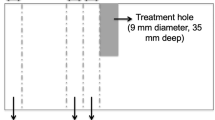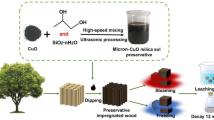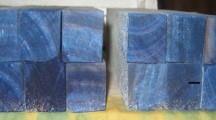Abstract
Chromated copper arsenate (CCA), an arsenicbased wood preservative, is toxic to human health and the environment. Although CCA is stable in seasoned wood, there are potential dangers during CCA manufacture, lumber treatment, and waste disposal. This research was conducted to study the effectiveness of soy products to replace toxic chromium and arsenic compounds in wood preservative formulations. Three soy product (Arpro 2100, HM 90, and Supro 760) were used as fixative agents in preservative solutions containing anhydrous CuSO4 and Na2B4O7·10H2O. The decay resistance of treated wood blocks was measured by a soil-block culture method. Despite the large molecular sizes of copper-protein and copper-boron-protein complexes, southern pine sapwood was treatable with these preservative formulations. Wood samples treated with >6 kg°m−3 CuSO4 and 7.5 kg·m−3 soy product, and subsequently leached for 3 d and exposed to the decay fungus Gloeophyllum trabeum (Fr.) Mur., sustained only 0.5% weight loss over 12 wk. Wood samples needed 40 kg·m−3 CuSO4 and 50 kg·m−3 soy protein to resist the copper-tolerant decay fungus Postia placenta (Fr.) M. Lars. & Lomb. These results suggest that soy-based wood preservatives can prevent wood products from fungal attack and can replace CCA.
Similar content being viewed by others
References
Preston, F.A., Wood Preservation: Trends of Today Will Influence the Industry Tomorrow, For. Prod. J. 50(9):12–19 (2000).
Nicholas, D.D., and T.P. Schultz, Biocides That Have Potential as Wood Preservatives—An Overview, Wood Preservation in the 90s and Beyond, Proceedings No. 7308, Forest Products Society, Madison, WI, 1994, pp. 169–173.
American Wood Preservers’ Association (AWPA), All Timber Products—Preservative Treatment by Pressure Processes, in AWPA Book of Standards, AWPA, Granbury, TX, 1999, pp. 23–32, C1-99.
Bland, D.E., Sorption of Copper by Wood Constituents, Nature 200:267 (1963).
Lin, S.Y., Method for the Treatment of Wood with Metal-Lignin Salts, U.S. Patent 5,246,739 (1993).
Thevenon, M.F., A. Pizzi, and J.P. Haluk, Protein Borates as Nontoxic, Long-Term, Wide-Spectrum, Ground-Contact Wood Preservatives, Holzforschung 52:241–248 (1998).
Laks, P.E., P.A. Mckaig, and R.W. Hemingway, Flavonoid Biocides: Wood Preservatives Based on Condensed Tannins, Ibid. 42:299–306 (1998).
American Society for Testing and Materials (ASTM), Standard Test Method for Wood Preservatives by Laboratory Soil Block Cultures, in Annual Book of ASTM Standards, ASTM International, West Conshohocken, PA, 2005, pp. 3–4, method D 1413-05b.
Baechler, R.H., and H.G. Roth, Laboratory Leaching and Decay Tests on Pine and Oak Blocks Treated with Several Preservative Salts, Proc. Am. Wood Preserv. Assoc. 52:24–33 (1956).
Johnson, B.R., and D.I. Gutzmer, Ammoniacal Copper Borate: A New Treatment for Wood Preservation, For. Prof. J. 28(2):33–36 (1978).
Johnson, B.R., Field Trials with Ammoniacal Copper Borate Wood Preservative, Ibid. 33(9):59–63 (1983).
Author information
Authors and Affiliations
Corresponding author
About this article
Cite this article
Yang, I., Kuo, M. & Myers, D.J. Soy protein combined with copper and boron compounds for providing effective wood preservation. J Amer Oil Chem Soc 83, 239–245 (2006). https://doi.org/10.1007/s11746-006-1199-6
Received:
Accepted:
Issue Date:
DOI: https://doi.org/10.1007/s11746-006-1199-6




